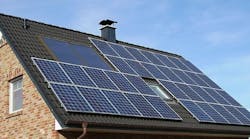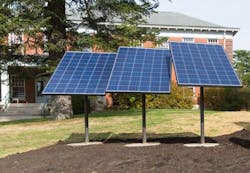For a majority of the United States' electricity and grid network's 100 plus year history, utilities have largely been unchallenged monopolies because of high barriers to market entry, among other reasons. Traditionally, electricity generation in the United States has relied on large, centralized assets, such as coal-fired power plants, to achieve economies of scale and supply cheap and reliable power to customers. However, as steep cost declines have enhanced the price competitiveness of alternative energy resources, a greater level of investment in technologies such as small-scale solar photovoltaic (PV) systems has ensued.
To illustrate, home and business owners have been at the forefront of this contemporary energy transition, often via the adoption of behind-the-meter distributed solar PV (that is, small rooftop or ground-mounted arrays) or micro wind turbines, also referred to as distributed generation (DG). Though still in its relative infancy, the exponential increase of DG has been revising the traditional electricity procurement model and forcing the utility industry to adapt. While there have been numerous arguments both for and against the value of DG on either side of the stakeholder aisle, despite protracted ideological battles, many utilities, for a variety of emerging reasons, are now embracing DG or at least exploring the prospect of doing so.
Historically, arguments in favor of DG deployment have largely been led by environmental nonprofit organizations, the renewable energy industry, and more progressive politicians. One argument, of course, relates to the myriad of environmental benefits of DG, such as reduced greenhouse gas (GHG) emissions, compared with conventional electricity generation via fossil fuels. Another pro argument is how DG can enhance economic development by creating/supporting jobs in industries such as solar module manufacturing or installation, in addition to stimulating local tax contributions for governments.
One advantage of DG that has unexpectedly come in handy in the face of coronavirus (COVID-19)-related disruptions is the stability that localized, renewable energy can provide, particularly as remote work and social distancing — at least in the short term — have become the new norm. Recent years have also given rise to growing concerns around emergency preparedness and being able to have resilient power sources in the event of grid disruptions, especially in areas prone to more natural disasters. Onsite energy generation not only reduces vulnerability to such disasters but it also has the added practical benefit of minimizing line losses seen through traditional electricity transmission as part of the centralized utility model.
Conversely, many have pushed back against the 'disruptive challenge' of DG deployment, including, at least historically, electric utilities themselves. One frequent argument is how lower revenues, given the decreased amount of electricity being purchased by ratepayers, has impacted utilities' bottom lines. Others have cited that DG is too intermittent to be reliable during peak hours. Another argument is how state net-metering laws have created a cross-subsidization situation, in which utilities have raised rates to cover grid upkeep, which are costs that are passed on to non-net-metering customers. Some utilities have taken it a step further by implementing monthly 'stand-by' charges for solar PV owners to help cover these costs, first championed by House Bill 1983 in Virginia in 2011.
Many opponents further contend that DG creates confusion regarding credits and fair compensation for owners. This led to several 'value of solar' studies conducted across the United States in the early 2010s, which sought to analyze the costs and benefits of DG, and how they should determine proper repayment mechanisms. As it were, current market prices and compensation rates for DG have created a situation that encourages investment and utilities have not always pushed back by altering rate structures. In essence, the natural, profit-maximizing behavior of utilities to keep electricity prices at a certain level has had unintended consequences of additional solar investment.
"The most important contribution that utilities make to the penetration of DG, whether consciously or not, is the failure to price usage sensitive rate elements of grid-produced electricity at the appropriate measure of marginal cost. Overcharging at the margin (but not in total) produces a powerful incentive for uneconomic bypass of the electric system and results in increasing levels of DG — all else held constant," said Howard Spinner, manager of regulatory affairs at Northern Virginia Electric Cooperative.
Despite these convoluted circumstances, some electric utilities are now more formally embracing, or beginning to embrace, DG. One fundamental reason is state renewable portfolio standards (RPS) mandates that require a certain percentage of regulated utilities' electricity mix to come from renewables, such as solar and wind. Often, instead of costly build-out of their own renewable generation, utilities will gladly purchase renewable energy credits (RECs) from local consumers to meet state RPS targets. Moreover, DG offers the opportunity to avoid or defer generation capacity. Avoided transmission and distribution (T&D) costs also provide a cost benefit to the utility and its customers, which is known and quantifiable.
Consumer demand has also largely driven utilities' move toward DG. This includes households, as well as large corporations like Amazon, Google, and Facebook who demand cheap and reliable power, and have targeted corporate sustainability missions. As these companies continue to grow and expand their geographic footprint, one potential attraction driver is the availability of local or onsite renewable energy generation. Many pioneering utilities have realized this value proposition and have started to employ strategies to allow large corporations to develop DG.
Obviously, not all electric utilities are embracing DG. Traditionally, large, investor-owned electric utilities have been more hesitant to welcome competition in this market, but cooperatives and municipally-owned utilities have been more democratic, flexible, and open to local innovation on these issues. For instance, many cooperatives have implemented unique adoption programs, or even community solar projects that enhance market access to those that cannot otherwise adopt DG, as seen in Minnesota. Either way, if utilities see ways in which DG can help them reduce or avoid infrastructure costs, as well as keep both large and small customers with new preferences happy, they will continue to tolerate additional adoption. Doing so, in turn, may create added benefits by way of peer effects and co-adoption, in which the deployment of other advanced energy technologies, such as battery storage and electric vehicles (EVs), occurs. This can also create a more modern and customer-centric grid.
While DG presents a number of justified challenges for utilities across the United States, deployment figures have continued to rise at a rapid rate, driven by demand, new decarbonization goals, steep cost declines, better designed policy mechanisms, and many other factors. By being receptive to this public demand and encouraging more objective research on the proper integration and costs/benefits of DG, utilities can be part of a just energy transition while also maximizing their own benefits and minimizing negative impacts to their operations. In essence, how can utilities derive more value from the already emerging DG markets? How will they adapt to the new grid of the future, which creates jobs and is part of a lower-carbon economy? The next decade will address these tough questions, as we see leader utilities emerge and laggard utilities fall behind during this industry shake-up. For many, it may be a classic case of, "If you can't beat 'em, join 'em."



